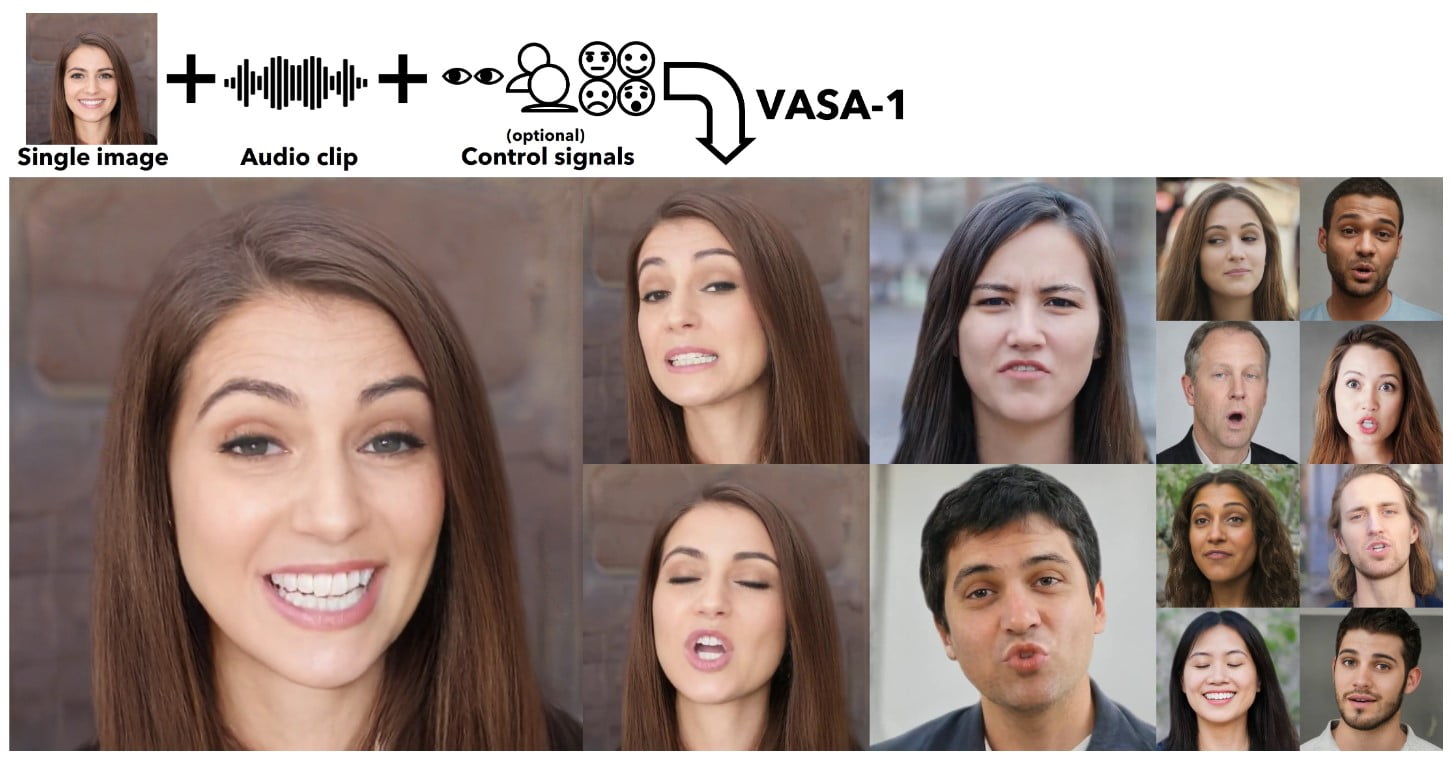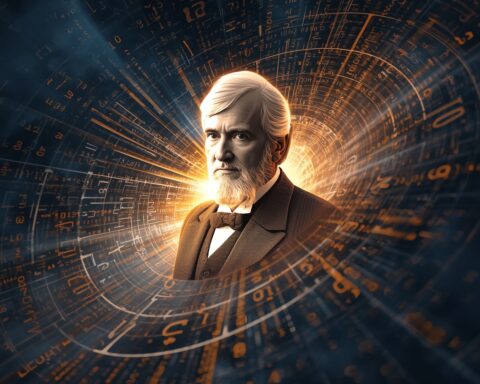Last Updated on April 19, 2024 7:48 am by Laszlo Szabo / NowadAIs | Published on April 19, 2024 by Laszlo Szabo / NowadAIs
Key Notes for Anyone Could be Realistic AI Avatar with Microsoft VASA-1
- Microsoft VASA-1 creates lifelike talking faces from static images and audio clips in real-time.
- Achieves realistic lip-audio synchronization, broad emotional expressions, and natural head movements.
- Functions at 45 fps in offline mode and 40 fps online, with 170ms latency on NVIDIA RTX 4090 GPU.
- Microsoft prioritizes ethical development and will delay release until responsible use is ensured.
- VASA-1 has potential applications in education, accessibility, and virtual companionship.
New AI Avatar Generator on the Field: Microsoft VASA-1
Microsoft has recently unveiled its AI model, VASA-1, which has the remarkable ability to generate lifelike talking faces in real time. This cutting-edge technology can create virtual or real characters that appear strikingly realistic, all from a single static image and a short audio clip. With VASA-1, Microsoft is pushing the boundaries of what AI can achieve in terms of creating lifelike avatars that emulate human conversational behaviors.
The Power of VASA-1
VASA-1 is capable of generating realistic lip-audio synchronization and capturing a broad range of emotions and facial nuances, as well as natural head motions. Even if a user’s desired output is not within the model’s training distribution, Vasa-1 can still generate realistic results. It can handle various inputs, including artistic photos, singing audios, and even non-English speech. This versatility makes Vasa-1 a powerful tool for creating lifelike avatars that can engage in real-time conversations.
Impressive Technical Specifications
In terms of technical capabilities, VASA-1 can generate video frames of 512×512 resolution at an impressive 45 frames per second (fps) in its offline batch processing mode. In its online streaming mode, it achieves a frame rate of 40fps with a latency of 170ms. These specifications were evaluated using a desktop PC equipped with an NVIDIA RTX 4090 GPU.
Responsible Development and Deployment
While Microsoft’s Vasa-1 has the potential to change the way we interact with virtual characters, the company is committed to ensuring responsible development and deployment of this technology.
“Given such context, we have no plans to release an online demo, API, product, additional implementation details, or any related offerings until we are certain that the technology will be used responsibly and in accordance with proper regulations.”
Microsoft has no plans to release an online demo, API, or any related offerings until it can be certain that the technology will be used responsibly and in accordance with proper regulations. Microsoft acknowledges the potential for misuse but emphasizes the substantial positive potential of Vasa-1, including enhancing educational equity, improving accessibility for individuals with communication challenges, and offering companionship or therapeutic support to those in need.
The Importance of Ethical AI Development
Microsoft’s cautious approach with Vasa-1 mirrors Meta’s decision not to release its generative AI model for speech, Voicebox, until synthetic speech can be more easily detected. Both companies recognize the potential for misuse and are committed to developing AI responsibly. Meta, for example, is working on techniques such as embedding artificial fingerprints that can be easily detected without compromising speech quality. This dedication to ethical AI development is crucial in preventing the abuse of powerful AI models like Vasa-1 for political purposes or cybercrime.
Enterprise Applications and Beyond
Numerous companies are already leveraging AI-generated avatars for various enterprise use-cases. One notable application is the use of AI interviewers to pre-screen applicants and conduct tests, alleviating the burden on HR staff. In countries like China and India, AI news anchors have also made their way to television screens, reading bulletins and even “interviewing” heads of state. Additionally, AI-generated “influencers” and models are gaining traction on social platforms, attracting followers and brand endorsements. The availability of highly convincing AI-generated video and speech models, such as Vasa-1, opens up vast possibilities but also raises concerns about potential misuse.
The Future of Lifelike Avatars
Microsoft’s Vasa-1 represents a significant step forward in the development of lifelike avatars that can engage in real-time conversations. The technology paves the way for more immersive and interactive experiences, enabling users to have lifelike interactions with virtual characters. While Vasa-1 is not yet publicly available, its potential applications extend beyond entertainment and could have a profound impact on areas such as education, accessibility, and therapeutic support.
Conclusion
Microsoft’s Vasa-1 AI model is revolutionizing the creation of lifelike avatars that can engage in real-time conversations. With its ability to generate realistic talking faces from a single image and audio clip, Vasa-1 pushes the boundaries of what AI can achieve. However, responsible development and deployment are paramount to prevent misuse. As Microsoft and other tech giants strive to develop AI ethically, the future holds incredible possibilities for lifelike avatars and their applications in various domains.
Definitions
- Microsoft: A global technology company known for its significant contributions to the software industry, cloud computing, and artificial intelligence development.
- Microsoft VASA-1: An AI model developed by Microsoft capable of generating real-time, lifelike avatars from static images and audio inputs, pushing forward the boundaries of digital human interaction.
- NVIDIA RTX 4090 GPU: A high-end graphics processing unit by NVIDIA, designed for demanding applications like gaming, AI development, and professional graphics work, known for its powerful performance capabilities.
- Frames per second (fps): A measure of how many unique consecutive images a computer graphics system can produce in one second. Higher fps rates allow for smoother animation and video playback.
- API: Application Programming Interface, a set of rules and tools for building software applications which specify how different software components should interact.
- AI generated influencers: Digital characters created using artificial intelligence that mimic human influencers; these entities can interact on social media platforms, promoting products or ideas as part of marketing strategies.
Frequently Asked Questions
- What makes Microsoft VASA-1 different from other AI avatar technologies? Microsoft VASA-1 uniquely combines high-resolution, real-time rendering with advanced emotional and motion accuracy, setting a new standard for realism in AI-generated avatars.
- How does Microsoft VASA-1 handle different languages and accents? VASA-1 is designed to be versatile, handling inputs across various languages and accents. This flexibility makes it suitable for global applications, from virtual customer service to multilingual educational tools.
- What are the potential uses for Microsoft VASA-1 in professional environments? Beyond entertainment, Microsoft VASA-1 can enhance remote education, provide accessible customer service avatars, and support therapeutic practices by creating more engaging and realistic interactions.
- What steps is Microsoft taking to ensure the ethical use of VASA-1? Microsoft is committed to responsible AI development, delaying the release of VASA-1 until it can ensure compliance with ethical guidelines and prevent potential misuse, reflecting a broader industry trend towards cautious AI deployment.
- Can Microsoft VASA-1 create avatars from any image and voice sample? Yes, VASA-1 can generate lifelike avatars from just a single image and a short audio clip, regardless of the image’s artistic style or the audio’s complexity, showcasing its advanced generative capabilities.








